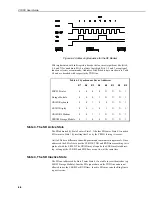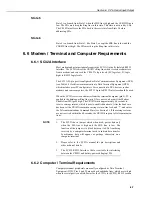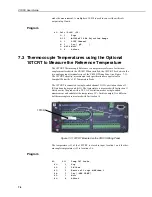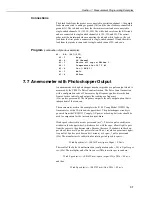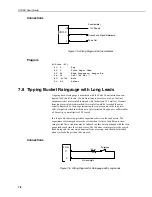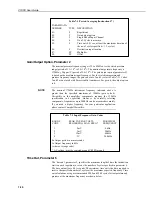
Section 7. Measurement Programming Examples
7-9
Program
01:Pulse (P3)
01:
1
Rep
02:
1
Pulse Input Chan
03:
2
Switch closure
04:
11
Loc [:RAIN mm ]
05:
0.2
Mult
06:
0
Offset
7.9 100
Ω
Ω
Ω
Ω
PRT in 4-Wire Half Bridge
Instruction 9 is the best choice for accuracy where the platinum resistance ther-
mometer (PRT) is separated from other bridge completion resistors by a lead
length having more than a few thousandths of an ohm resistance. In this example,
it is desired to measure a temperature in the range of -10°C to +40°C. The length
of the cable from the CR10X to the PRT is 170m.
Figure 7-7 shows the circuit used to measure the PRT. The 10k
Ω
resistor allows
the use of a high excitation voltage and low voltage ranges on the measurements.
This ensures that noise in the excitation does not have an effect on signal noise.
Because the fixed resistor (R
f
) and the PRT (R
s
) have approximately the same
resistance, the differential measurement of the voltage drop across the PRT can be
made on the same range as the differential measurement of the voltage drop
across R
f
.
Connections
Figure 7-7 Wiring Diagram for PRT in 4-Wire Half Bridge
If the voltage drop across the PRT (V
2
) is kept under 50mV, self heating of the
PRT should be less than 0.001
o
C in still air. The best resolution is obtained when
the excitation voltage is large enough to cause the signal voltage to fill the
measurement voltage range. The resolution of this measurement on the 25mV
range is +0.04
o
C. The voltage drop across the PRT is equal to V
x
multiplied by
the ratio of R
s
to the total resistance, and is greatest when R
s
is greatest
(R
s
=115.54
Ω
at 40
o
C). To find the maximum excitation voltage that can be used,
we assume V
2
equal to 25mV and use Ohm’s Law to solve for the resulting
current, I.
I = 25/R
s
= 25/115.54 = 0.216mA
Next solve for V
x
:
V
x
= I(R
1
+R
s
+R
f
) = 2.21V
If the actual resistances were the nominal values, the CR10X would not overrange
with V
x
= 2.2V. To allow for the tolerances in the actual resistances, it is decided
to set V
x
equal to 2.1V (e.g. if the 10k
Ω
resistor is 5% low, then
Vx
R1 10k
Ω


